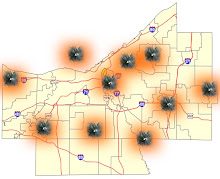BOTC took a little vacation time last week and visited Cape May, New Jersey, a Victorian beach town at the southern tip of state. We had an enjoyable time—the future Mrs. Doctor enjoyed the beaches, while I enjoyed the resort town landscape and geography.
Resort + vacation towns are “urban” anomalies, unlike the typical American urban or suburban conurbations. A town is in constant flux, shuffling new populations of tourists and vacationers every few days. A resort community may maintain, sustain, and promote an atmosphere. Animated public spaces possessing all the accruements of a pedestrian environment are filled with people day and night. Vehicular traffic is limited, as well as asphalt parking lots.
Cape May is no different. Tourists, like us, come in for a few days, become quasi-citizens use the city and beaches, and then leave. The town tries to maintain a Victorian aesthetic presence with many of its beautiful bed and breakfasts, cottages, and vacation homes (“Idustri-victorian” architect Frank Furness designed buildings in town). Houses are grouped tightly together on narrow tree-lined streets with flagstone sidewalks. The ocean-front avenue and the Washington Street Pedestrian Mall are engaging public spaces, full of people, activities, pleasant aromas, shading vegetation. Cape May is a pleasant place.
But why can we not transfer such conditions back to our everyday lives back in the suburbs of Cleveland? This is an old and tired question that always devolves into the typical clichéd answers, political disagreements, and arguments. I cannot assert any answers or new solutions myself.
Yet quick trips to these urban anomalies always refresh the inner-debate between desires for a new pleasant populist (sub)urbanism and a more aggressive, progressive, and density-driven urbanism.
Subscribe to:
Post Comments (Atom)





No comments:
Post a Comment